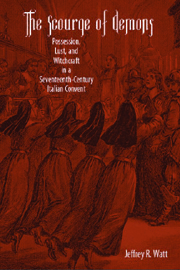Book contents
- Frontmatter
- Contents
- List of Illustrations
- Acknowledgments
- Introduction: Nuns, Witchcraft, and the Inquisition
- Chapter 1 Female Religious, Claustration, and Santa Chiara of Carpi
- Chapter 2 The Outbreak and Maleficia
- Chapter 3 The Confessor and Love Magic
- Chapter 4 The Exorcists and the Demons
- Chapter 5 Sisters Dealta and Ippolita under Attack
- Chapter 6 Bellacappa's Defense
- Chapter 7 The Waning of the Possessions
- Conclusion
- Appendix A
- Appendix B
- List of Abbreviations
- Notes
- Selected Bibliography
- Index
Chapter 1 - Female Religious, Claustration, and Santa Chiara of Carpi
Published online by Cambridge University Press: 12 September 2012
- Frontmatter
- Contents
- List of Illustrations
- Acknowledgments
- Introduction: Nuns, Witchcraft, and the Inquisition
- Chapter 1 Female Religious, Claustration, and Santa Chiara of Carpi
- Chapter 2 The Outbreak and Maleficia
- Chapter 3 The Confessor and Love Magic
- Chapter 4 The Exorcists and the Demons
- Chapter 5 Sisters Dealta and Ippolita under Attack
- Chapter 6 Bellacappa's Defense
- Chapter 7 The Waning of the Possessions
- Conclusion
- Appendix A
- Appendix B
- List of Abbreviations
- Notes
- Selected Bibliography
- Index
Summary
For centuries Roman Catholic Church leaders had preached that the celibate life was superior to matrimony and believed that women had a stronger libido and were more easily led into temptation than men. Given women's supposed propensity to lust and commit other sins, the convent was viewed as the site where women could best pursue a life of virtue. A degree of enclosure had always been part of monasticism. The contemplative life, aspired to by both monks and nuns, required a considerable degree of peace, solitude, and separation from the world. Enclosure, however, was always viewed as more essential for female than male religious. When enclosure of nunneries was introduced in the early Middle Ages, it was primarily viewed as necessary for the physical protection of nuns in an era of invasions, endemic violence, and political instability. In the central Middle Ages, churchmen called for the enclosure of convents for another reason: the need to keep nuns entirely separate from males to preserve their sexual purity, based on the misogynous assumptions that women were by nature more prone to sin, less able to control their impulses, and unable to govern themselves. In 1298 Pope Boniface VIII published a decree, Periculoso, that mandated enclosure for all professed nuns, women who had taken the solemn or perpetual vows of poverty, chastity, and obedience. The degree of enclosure varied greatly, however, from convent to convent into the Counter-Reformation era.
- Type
- Chapter
- Information
- The Scourge of DemonsPossession, Lust, and Witchcraft in a Seventeenth-Century Italian Convent, pp. 21 - 36Publisher: Boydell & BrewerPrint publication year: 2009



